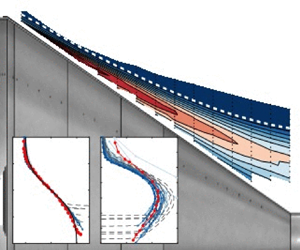Article contents
The structure of a highly decelerated axisymmetric turbulent boundary layer
Published online by Cambridge University Press: 19 October 2021
Abstract

Experiments were performed over a body of revolution at a length-based Reynolds number of 1.9 million. While the lateral curvature parameters are moderate ( $\delta /r_s < 2, r_s^+>500$, where
$\delta /r_s < 2, r_s^+>500$, where  $\delta$ is the boundary layer thickness and rs is the radius of curvature), the pressure gradient is increasingly adverse (
$\delta$ is the boundary layer thickness and rs is the radius of curvature), the pressure gradient is increasingly adverse ( $\beta _{C} \in [5 \text {--} 18]$ where
$\beta _{C} \in [5 \text {--} 18]$ where  $\beta_{C}$ is Clauser’s pressure gradient parameter), representative of vehicle-relevant conditions. The mean flow in the outer regions of this fully attached boundary layer displays some properties of a free-shear layer, with the mean-velocity and turbulence intensity profiles attaining self-similarity with the ‘embedded shear layer’ scaling (Schatzman & Thomas, J. Fluid Mech., vol. 815, 2017, pp. 592–642). Spectral analysis of the streamwise turbulence revealed that, as the mean flow decelerates, the large-scale motions energize across the boundary layer, growing proportionally with the boundary layer thickness. When scaled with the shear layer parameters, the distribution of the energy in the low-frequency region is approximately self-similar, emphasizing the role of the embedded shear layer in the large-scale motions. The correlation structure of the boundary layer is discussed at length to supply information towards the development of turbulence and aeroacoustic models. One major finding is that the estimation of integral turbulence length scales from single-point measurements, via Taylor's hypothesis, requires significant corrections to the convection velocity in the inner 50 % of the boundary layer. The apparent convection velocity (estimated from the ratio of integral length scale to the time scale), is approximately 40 % greater than the local mean velocity, suggesting the turbulence is convected much faster than previously thought. Closer to the wall even higher corrections are required.
$\beta_{C}$ is Clauser’s pressure gradient parameter), representative of vehicle-relevant conditions. The mean flow in the outer regions of this fully attached boundary layer displays some properties of a free-shear layer, with the mean-velocity and turbulence intensity profiles attaining self-similarity with the ‘embedded shear layer’ scaling (Schatzman & Thomas, J. Fluid Mech., vol. 815, 2017, pp. 592–642). Spectral analysis of the streamwise turbulence revealed that, as the mean flow decelerates, the large-scale motions energize across the boundary layer, growing proportionally with the boundary layer thickness. When scaled with the shear layer parameters, the distribution of the energy in the low-frequency region is approximately self-similar, emphasizing the role of the embedded shear layer in the large-scale motions. The correlation structure of the boundary layer is discussed at length to supply information towards the development of turbulence and aeroacoustic models. One major finding is that the estimation of integral turbulence length scales from single-point measurements, via Taylor's hypothesis, requires significant corrections to the convection velocity in the inner 50 % of the boundary layer. The apparent convection velocity (estimated from the ratio of integral length scale to the time scale), is approximately 40 % greater than the local mean velocity, suggesting the turbulence is convected much faster than previously thought. Closer to the wall even higher corrections are required.
JFM classification
- Type
- JFM Papers
- Information
- Copyright
- © The Author(s), 2021. Published by Cambridge University Press
References
REFERENCES
- 7
- Cited by





